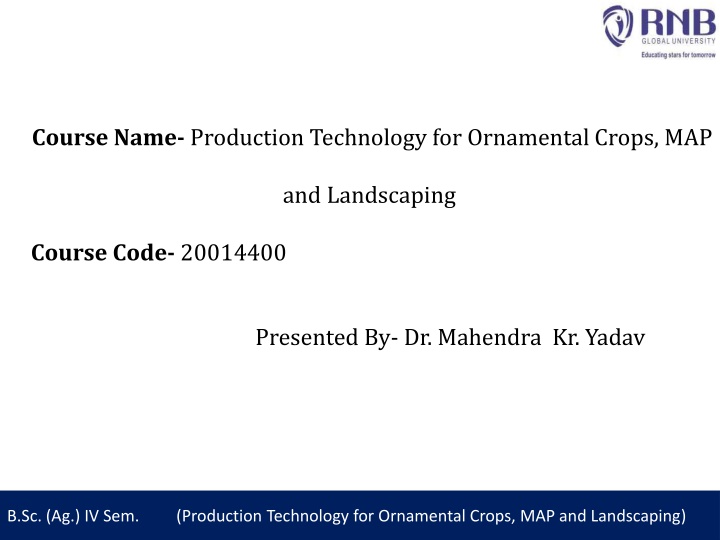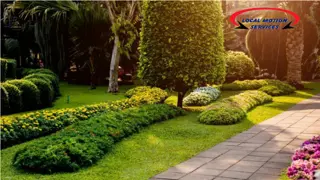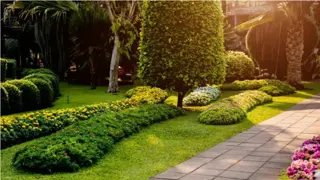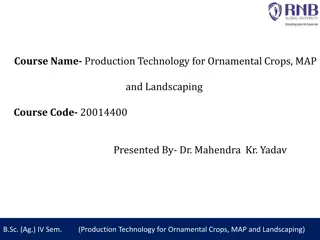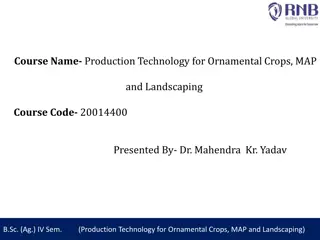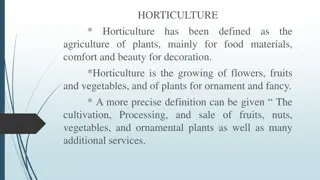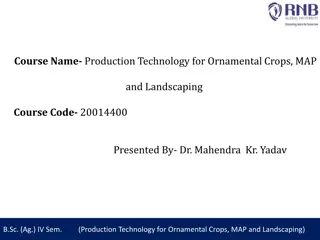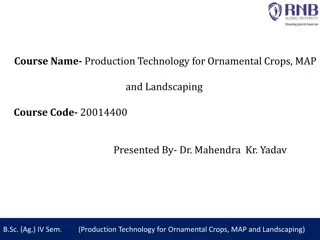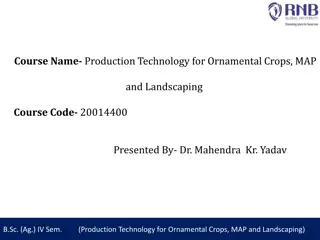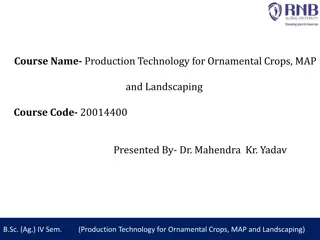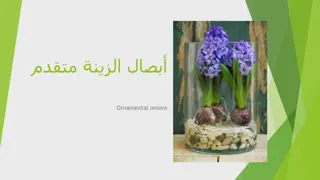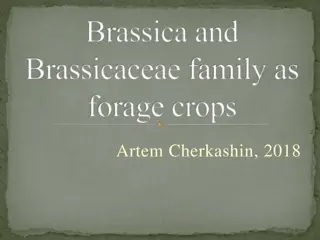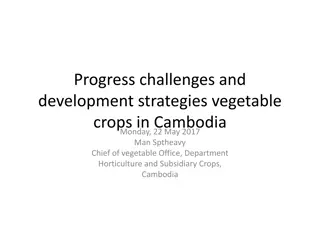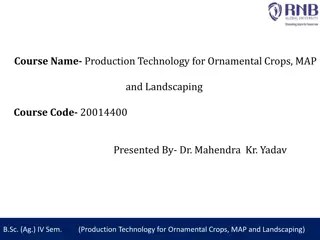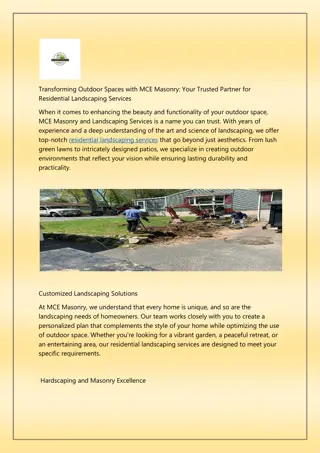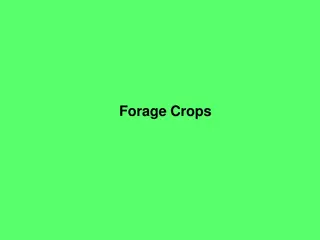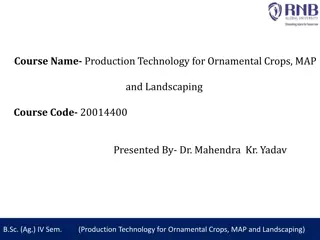Production Technology for Ornamental Crops and Landscaping Course Overview
This course provides a comprehensive study on the production technology for ornamental crops, medicinal plants, and landscaping practices. Topics include identification of different crops, landscaping principles, package of practices for flowers, processing techniques, and more. Students will learn about drying methods for flowers, such as air drying, sun drying, and oven drying. The importance of value addition in ornamental crops and medicinal plants is also highlighted.
Download Presentation

Please find below an Image/Link to download the presentation.
The content on the website is provided AS IS for your information and personal use only. It may not be sold, licensed, or shared on other websites without obtaining consent from the author.If you encounter any issues during the download, it is possible that the publisher has removed the file from their server.
You are allowed to download the files provided on this website for personal or commercial use, subject to the condition that they are used lawfully. All files are the property of their respective owners.
The content on the website is provided AS IS for your information and personal use only. It may not be sold, licensed, or shared on other websites without obtaining consent from the author.
E N D
Presentation Transcript
Course Name- Production Technology for Ornamental Crops, MAP and Landscaping Course Code- 20014400 Presented By- Dr. Mahendra Kr. Yadav B.Sc. (Ag.) IV Sem. (Production Technology for Ornamental Crops, MAP and Landscaping)
Course Objectives Identify different types of ornamental and medicinal crops. Examine various principles of landscaping, uses of landscape trees, shrubs and climbers, production technology of important ornamental crops, etc. Determine about Demonstrate various Package of practices for loose flowers and their transportation, storage house and required condition for cut and loose flower. Construct about the various problems with the production technology of medicinal and aromatic plants. Importance of Processing and value addition in ornamental crops and MAPs produce. B.Sc. (Ag.) IV Sem. (Production Technology for Ornamental Crops, MAP and Landscaping)
Processing and value addition in ornamental crops and MAPs produce. B.Sc. (Ag.) IV Sem. (Production Technology for Ornamental Crops, MAP and Landscaping)
A) DRY FLOWERS Processes in dry flower making A) DRYING i. Air drying Tie the flowers in loose bunches and hang upside down until they are dry in a room with good ventilation and darkness. It is the ideal method for seedpods, grasses and many flowers having more cellulose material. Crisp textured flowers like Helipterum, Helichrysum and Limonium could easily be dried either by hanging or positioning them erect in containers for 1-2 weeks. Gomphrena flowers from half to full bloom maturity take 7-9 days for air drying and roses take 5-10 days. Acacia, amaranths, castor flowers, citrus leaves, cockscomb, corn flower, fennel, fern, golden rod, gypsophila, grasses, herbs, ear heads of wheat, oat and rye, hydrangea, lavender, protea, marigold, poppy seed pods, physalis, peppers, roses, statice, thistle, yarrow and yucca can be dried by this method. B.Sc. (Ag.) IV Sem. (Production Technology for Ornamental Crops, MAP and Landscaping)
ii. Sun drying Plant material is embedded in drying medium (sand) in a container and exposed to the sun daily to facilitate rapid dehydration. In India, open sun drying is followed for drying many flowers. Flowers like small zinnias, marigolds, pansies, and pompon chrysanthemum embedded in sand upside down fashion and kept in the Sun would dry in a day or two. For Gomphrena, Zinnia and French marigold it would take 3-4 days. Open sun drying is followed for corn flowers, custard apple (small), Casuarina pods, mini coconut, eucalyptus, evergreen cones, gomphrena, gourds, pomegranates, poppy pods, lotus pods, typha heads, palm leaves, grass ear heads. iii. Oven drying Electrically operated hot air oven at a controlled temperature of 40-50 oC is used for drying flowers in an embedded condition. Chrysanthemum, dombeya, gerbera, and limonium take 48 hours at 45-49 C, French marigold takes 72 hours, African marigold takes 96 hours and Nymphaea takes 120 hours for drying. China aster, delphinium, rose buds and small flowers, and zinnia take 48 hours at 40 - 44 oC, medium and large roses take 72 hours and very large flowers take 96 hours in 40 - 44 oc. B.Sc. (Ag.) IV Sem. (Production Technology for Ornamental Crops, MAP and Landscaping)
iv. Embedding method Embedding the flowers in a granular, desiccating material is probably the most commonly used method and many consider it the best all around method. Several materials may be used, and they vary in cost and the results that they produce. v. Microwave oven drying Electronically produced microwaves liberate moisture from organic substances by agitating the water molecule. It is fast and the results are good. The flowers has to be embedded in silica gel medium in a microwave safe open container along with a small cup with water nearby. Standing time of 10 minutes to few hours is needed after the drying for best results. B.Sc. (Ag.) IV Sem. (Production Technology for Ornamental Crops, MAP and Landscaping)
vi. Glycerin drying (glycerinization) Glycerinizing is the term used in the ornamental cut flowers and foliage industry to describe the treatment of fresh plant materials with a hygroscopic (water attracting) chemical with the objective of retaining the suppleness of the plant materials. Foliage treated with glycerin keeps almost indefinitely and remains pliable. Glycerin preserves foliage by replacing the natural moisture present in the leaf with a substance that maintains the leaf form, texture and sometimes the colour. Fresh and fairly matured foliage is ideal for glycerining. About 50 per cent of most plant fresh weight is water, but brittleness is usually only a problem if the water content falls below 10 per cent. B.Sc. (Ag.) IV Sem. (Production Technology for Ornamental Crops, MAP and Landscaping)
vii. Freeze drying Freeze dried flowers are fresh flowers that have been specially dried to preserve their natural shape, colour and beauty. Freeze drying is accomplished by a process called sublimation. It requires a special freeze-drying machine. It involves first freezing the flowers at (-) 10 oC for at least 12 hours. A vacuum pump slowly pulls the water out of the flowers as a vapor in one chamber, and then the vapor condenses as ice in another chamber. Because of this process, the shape and natural color of the flower is maintained. For Roses it takes 15 17 days and for other flowers normally 10 12 days. Major flowers dried by this method are roses, carnation, bridal bouquets etc. B.Sc. (Ag.) IV Sem. (Production Technology for Ornamental Crops, MAP and Landscaping)
viii. Press drying Flowers and foliage are placed in-between two folds of newspaper sheets or blotting paper and these sheets are kept one over other and corrugated boards of the same size are placed in between the folded sheets so as to allow the water vapour to escape. The whole bundle is then placed in the plant press, its screws tightened. After 24 hours the bundle is removed to an electric hot air oven for 24 hours at 40-45 oC. The following flowers and foliage are dried by this method. Flowers: Candytuft, Chrysanthemum, Euphorbia, Lantana, Larkspur, Mussaenda, Pansy, Pentas, Rose and Verbena, and Foliage: Thuja, Taxodium, Marigold, Grevillea, Rose, Ferns, Casuarina, Silver oak and Grasses B.Sc. (Ag.) IV Sem. (Production Technology for Ornamental Crops, MAP and Landscaping)
(B) Bleaching Bleached ornamental plant material provides a striking contrast when arranged with dried or dyed flowers. Bleaching also allows the use of dyes for colouring. Oxidative (Hypochlorite, Chlorite and Peroxide) and reductive bleaching chemicals (Sulphite and Borohydride) are used for bleaching ornamental flowers and foliage. Profitability is depended upon attainment of high white quality and on cost efficient utilization of expensive bleaching chemicals. Sodium Chlorite is an excellent bleaching agent because it is relatively selective for lignin without damaging fibre. Optimum pH (4.5- 3.5) and temperature (70 C) is to be maintained for effective chlorite action. Hydrogen Peroxide may be more practical for some plant materials because it is less expensive. Sodium Chlorite 10 % solution at 70 C is ideal for complete colour removal of pink Gomphrena flowers in to pure white flowers at 7 hours of immersion. Hydrogen peroxide 30% also takes 7 hours for complete colour removal of Gomphrena. B.Sc. (Ag.) IV Sem. (Production Technology for Ornamental Crops, MAP and Landscaping)
(3) Dyeing Though preserving flowers with their natural colour is more appealing, some plant parts need artificial dyeing to improve the colour. Systemic dyes are available for use. They are acidic-anionic dyes, which are combined with water and glycerin to form a preservation solution that is absorbed by fresh cut flowers and foliage through the stem of the plant. As the water evaporates, it leaves behind the dye and glycerin for our desired colour. Normally 1.5 ml to 5 ml dye/l of solution is prepared. Colour take and preservation will take 2-8 days. B.Sc. (Ag.) IV Sem. (Production Technology for Ornamental Crops, MAP and Landscaping)
Distillation of Essential Oil 1. WATER DISTILLATION This is simple method in which plant material is distilled comes in direct contact with boiling water in a distillation unit. This method is advantageous for certain material when they are in powered form. But this method is not good for material containing saponifiable or high boiling point constituents. Delicate flowers such as roses and orange blossoms would clump together when introduced to steam in the distillation process. The water protects the extracted oil from overheating. The condensed liquids cool down and separate from each other. The remaining water, which can sometimes be fragrant, is referred to by several names including hydrolate, hydrosol, herbal water, essential water, floral water, or herbal distillate. B.Sc. (Ag.) IV Sem. (Production Technology for Ornamental Crops, MAP and Landscaping)
2. STEAM DISTILLATION PROCESS A large container called a Still, which is usually made of stainless steel, containing the plant material has steam added to it. Through an inlet, steam is injected through the plant material containing the desired oils, releasing the plant s aromatic molecules and turning them into vapor. In this method steam does not penetrate the cell membranes and the essential oil i vapouried only after diffusing out as an aqueous solution through the cell membrane. The vaporized plant compounds travel to the condensation flask or the Condenser. Here, two separate pipes make it possible for hot water to exit and for cold water to enter the Condenser. This makes the vapor cool back into liquid form. The aromatic liquid by-product drops from the Condenser and collects inside a receptacle underneath it, which is called a Separator. Because water and oil do not mix, the essential oil floats on top of the water. From here, it is siphoned off. Quality of oil is also good in this method. (Some essential oils are heavier than water, such as clove essential oil, so they are found at the bottom of the Separator.) B.Sc. (Ag.) IV Sem. (Production Technology for Ornamental Crops, MAP and Landscaping)
1. Solvent extraction This method employs food grade solvents like hexane and ethanol to isolate essential oils from plant material. It is best suited for plant materials that yield low amounts of essential oil, that are largely resinous, or that are delicate aromatics unable to withstand the pressure and distress of steam distillation. This method also produces a finer fragrance than any type of distillation method. Through this process, the non-volatile plant material such as waxes and pigments, are also extracted and sometimes removed through other processes. Once the plant material has been treated with the solvent, it produces a waxy aromatic compound called a "concrete." When this concrete substance is mixed with alcohol, the oil particles are released. The aforementioned chemicals used in the process then remain in the oil and the oil is used in perfumes by the perfume industry or for aromatherapy purposes. B.Sc. (Ag.) IV Sem. (Production Technology for Ornamental Crops, MAP and Landscaping)
